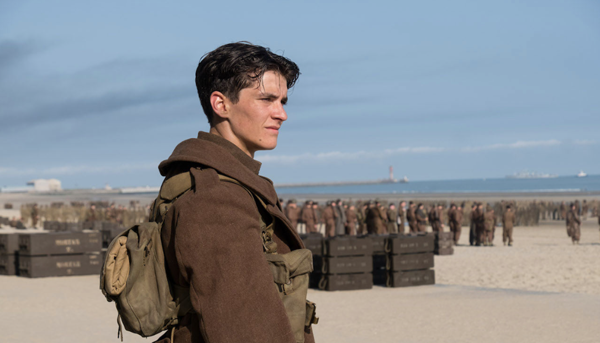
To start, Dunkirk is sure to go down as one of the greatest depictions of war ever captured on film. One reason, no doubt, is director Christopher Nolan’s choice to use film, filming most of the movie in 65 and 70mm IMAX format. Another is Nolan’s use of real warships and fighter jets, creating a tangible and immersive breadth of scope and size. Perhaps the greatest reason, though, is Nolan’s focus on one moment in the greater war, told from the singular perspective of the British forces’ fight for survival.
The title refers to the coastal town in France besieged by the German army in WWII, a mere 50 miles across the Channel to England. It opens on the foot soldier Tommy (Whitehead) as he escapes the town to arrive at the beach only to find queues and queues of soldiers just like him waiting for rescue. Tommy gloms on to different groups of survivors, jumping from ship to sinking ship in pure desperation. As German bombers pepper the boats below, British fighter pilots in Spitfires attempt to shoot them down. Who better to play one of these mostly masked, nearly mute pilots than Bane himself, Tom Hardy. Perhaps the most intriguing and satisfying thread comes from across the Channel, as the British Navy commissions all commercial and private boats to sail to Dunkirk. Mark Rylance is a standout as Mr. Dawson, who takes his own vessel straight to the battle, volunteering himself and his boat to the cause rather than just his boat.
Nolan says he looked to old silent epics for inspiration, and Dunkirk mirrors those sword-and-sandal classics in scale and spectacle, using roughly 1,000 extras on the beaches and over 50 actual ships at sea. The effect is staggering; the beaches of Dunkirk feel vibrant and alive even as the specter of death looms over every inch of sand, sea and ship as well as in the air above.
Adhering to his silent-era inspiration, Nolan keeps the dialogue to a minimum, swapping developed characters for evocative vessels of pure, visceral dread. The soundtrack, conversely, is relentless, much like the barrage of bombs and bullets from the all-but-unseen Germans. Hans Zimmer’s score constantly ramps up the tension with its rhythmic, dissonant strings and a nervy, altered recording of one of the director’s actual pocket watches. The point of such a jarring and unceasing theme is not lost, but it verges on overkill, often forcing a sense of impending doom rather than supplementing it. Some 30 veterans of Dunkirk said as much at a premiere in London, claiming that the music was louder than the actual bombardment. There are moments where a palpable silence would have been scarier than any possible sound, a minor quibble for an otherwise engrossing and astounding picture.












